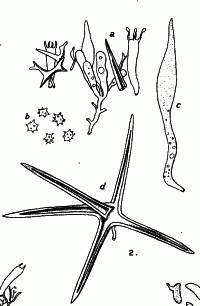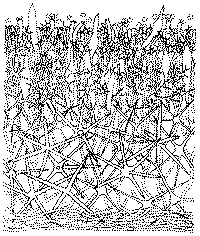|
 Asterostroma persimile Asterostroma persimile
BiostatusPresent in region - Indigenous. Non endemic
Images (click to enlarge)
Caption: PLATE I. Fig. 2. Asterostroma persimile n. sp. All figures x about 650.
a. Portion of hymenium. b. Spores. c. Gloeocystidium. d. Brown stellate hypha from tissue. | 
Caption: FIG. 1. Section through Asterostroma persimile, x 500. |
Article: Wakefield, E.M. (1915). On a collection of fungi from Australia and New Zealand. Kew Bulletin of Miscellaneous Information 1915(8): 361-376.
Notes: Exactly resembling in appearance A. cervicolor, to which species this plant was at first
referred. It is also close to A. cervicolor in the general type of structure; but differs in the
spores, which are angular, with large conical warts like those of Inocybe asterospora, instead
of being globose with small spines. The stellate hyphae are also somewhat coarser. It might
perhaps be regarded as a variety (geographical?) of A. cervicolor.
Article: Cunningham, G.H. (1955). Thelephoraceae of New Zealand. Part V. The genus Asterostroma. Transactions of the Royal Society of New Zealand 83(2): 241-245.
Description: Hymenophore annual, often reviving a second season, sometimes vaguely stratose,
membranous, loosely attached, effused forming irregular areas to 10 x 6 cm; surface clay
colour, tan, bay-brown or ochre, according to age and hymenial development, even,
sometimes pruinose, at length scantily creviced; margin thinning out, clay colour or tan,
fibrillose, loosely attached, rhizomorphs rare, when present pallid tan. Context tan or
ferruginous, 250-900 µ thick, composed of a thin base of parallel hyphae, an intermediate
layer of scanty woven hyphae and masses of stellate setae which are progressively smaller
and lighter in colour from base to surface, sometimes obscurely stratose; generative hyphae
2.5-3.5 µ diameter, wall 0.2 µ thick, hyaline, brandied, septate. Hymenial layer 60-130 µ
deep, of basidia, paraphyses, gloeocystidia and asterophyses arranged in a loose palisade.
Basidia cylindrical, a few subclavate, projecting, 24-32 x 5-6 µ, 4-spored; sterigmata slender,
to 6 µ long. Paraphyses subclavate, about half the length of and narrower than the basidia.
Gloeocystidia confined to the hymenial layer, projecting to 30 µ, or not, fusiform or
subclavate with bluntly acuminate apices, 80-110 x 10-14 µ, wall naked, 0.5-1 µ thick,
hyaline. Asterophyses forming the bulk of the hymenial layer, sometimes arranged in several
vague zones, composed of subclavate bodies bearing 4-7 short aculeate rays which are
sometimes once or twice bifid, attached to long and narrow pedicels often freely geniculated,
and sometimes bearing two or three asterophyses in chains. Stellate setae chestnut-brown, 25-150 µ
diameter, composed of 3-7 commonly 4-5 aculeate rays each 15-80 µ long, attached
radiately to a slightly inflated boss, sometimes bifid. Spores globose or subglobose, appearing
angular, 7-10 µ diameter (including spines), wall hyaline, 0-5 µ thick, coarsely echinulate-verrucose,
spines acuminate, to 3 µ long.
Habitat: HABITAT. Effused on decayed bark or decorticated wood.
Distribution: TYPE LOCALITY. Rotorua, New Zealand.
DISTRIBUTION. New Zealand, Australia, Malaya?
Notes: Separated readily from other species, save A. medium Bres., by the coarsely verrucose-echinulate
spores. Spines of these are large, with broad bases and acuminate apices, and give
to spores an angular appearance though they are globose or subglobose. Although the spores
resemble those of A. medium, our species differs in the presence of abundant asterophyses,
larger gloeocystidia and much thicker often stratose context.
Surface colour varies appreciably. When sterile plants are darker since many of the coloured
stellate setae project; when fertile they assume a lighter colour and often appear pruinose
owing to the projecting gloeocystidia. The hymenial layer may be pulled off readily since it is
feebly attached by the scanty generative hyphae.
A collection of A. persimile from Australia is in Kew herbarium, donated by the late C.G.
Lloyd; and it is possible that it occurs also in Malaya since a drawing by Corner (Trans. Brit.
Myc. Soc., 31, 242, 1948) could well be of this species.
|